CB FEATURES


By Robert Smith
Tom Grenon
photos
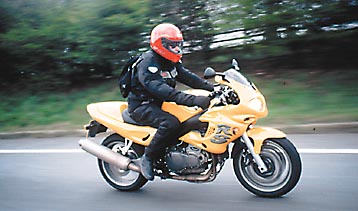 With a full English breakfast,
including the infamous "black pudding" (don't ask...) floating in my stomach,
I found the Triumph Sprint RS where I'd left it - in a motorcycle parking
bay (Yes, they really exist!) just off Sloane Square in London's Chelsea district.
I climbed on to the firm seat, pulled in the clutch and - remembering not
to open the throttle - pushed the start button. The whine from the fuel pump
gave way to the familiar diesel tractor sound of the idling triple. The cable
clutch was noticeably heavier than the hydraulic type on my '96 Sprint, and
the gearbox notchier as I crunched into first. Pulling away, there was no
need to rev the engine - the steam engine torque kicked in as low as 1,500
rpm
With a full English breakfast,
including the infamous "black pudding" (don't ask...) floating in my stomach,
I found the Triumph Sprint RS where I'd left it - in a motorcycle parking
bay (Yes, they really exist!) just off Sloane Square in London's Chelsea district.
I climbed on to the firm seat, pulled in the clutch and - remembering not
to open the throttle - pushed the start button. The whine from the fuel pump
gave way to the familiar diesel tractor sound of the idling triple. The cable
clutch was noticeably heavier than the hydraulic type on my '96 Sprint, and
the gearbox notchier as I crunched into first. Pulling away, there was no
need to rev the engine - the steam engine torque kicked in as low as 1,500
rpm
The Sprint makes a pretty
good commuter tool in the Big Smoke. It has enough presence to intimidate
the scads of scooters that swarm around you at every intersection, yet it's
light and slender enough to squeeze between lines of cars. The torquey engine
is helpful, pulling you out of danger even when you forget to change down.
But I was disappointed not to be able to get into neutral easily at a standstill.
Other testers have not reported this to be a problem, so it 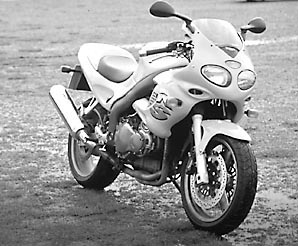 may have been my bike. I deked and
floated through London's gridlocked streets, enjoying the privilege of lane
splitting, to join the A1 Motorway. Sprinting north toward Peterborough and
Grantham, I was enjoying the Sprint's riding position - not as radical as
I'd expected and nicely balanced with the wind support from a 90 mph forward
speed - when an equation from high school physics popped into my brain....F=ma...
may have been my bike. I deked and
floated through London's gridlocked streets, enjoying the privilege of lane
splitting, to join the A1 Motorway. Sprinting north toward Peterborough and
Grantham, I was enjoying the Sprint's riding position - not as radical as
I'd expected and nicely balanced with the wind support from a 90 mph forward
speed - when an equation from high school physics popped into my brain....F=ma...
A simple expression of Newton's second law, I realized these three letters summed up my thoughts about the RS. I'd been struggling for a way to describe its superficial yet distinct differences from the Sprint ST. But where did that equation come from? Was it a subconscious channeling of the repeated road signs to Grantham, where Isaac Newton went to school? Hmmm... Let's see. The RS and ST share the same engine, so they apply the same force (F). But the RS weighs about eight kg less than the ST, so its mass (M) is about five per cent less. Even though this idea will be familiar to rocket scientists, it shouldn't take one to work out that if the force is the same and the mass smaller, acceleration will be greater. Like, duh!
So is the RS five per cent faster off the line? I didn't time them, but the RS definitely seems to haul its Bridgestone-clad ass away a decent amount quicker than the ST. And it isn't just straight-line acceleration. The weight peeled away from the T695 results in faster handling too. Throwing the bike from a quick left turn to a fast right reveals just how flickable the package has become. Less inertia means less effort to change direction. F=ma in action again.
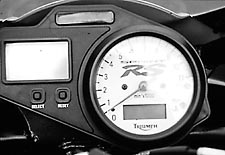 Sweet-torquing
Sweet-torquing
Much has
been written in the motorcycle press about Triumph's 110-hp 955i triple and
its flat torque curve. Reviewers also talk a lot about torque rather than
power when it comes to today's chromo-cruisers. A flat torque curve apparently
makes for smooth power delivery - but why? With nothing much else to think
about as the signposts on the A1M slid by, I thought I'd see if I could
remember any more high school physics. Power is really just a measure of how
fast an engine can deliver torque. If an engine's torque curve is "flat" from,
say, 3,000 rpm to 6,000 rpm, the power output at 6,000 rpm will be twice that
at 3,000 rpm.
Motorcycles have a much higher power-to-weight ratio than your average car, yet don't necessarily turn in a much greater top speed. The reason? Wind resistance rather than weight is a much bigger factor in motorcycle top speed. Once you've got both of them rolling at a specific speed, the rolling resistance of a car and a bike aren't that much different. But a bike (and rider) usually has a higher drag factor, and usually has lower absolute power. So a motorcycle needs to build power as the revs climb to overcome drag, while a car engine needs more power (and torque) lower down to get the greater mass rolling.
So why is low-down torque
becoming a cruisebike's benchmark? Two things. One of 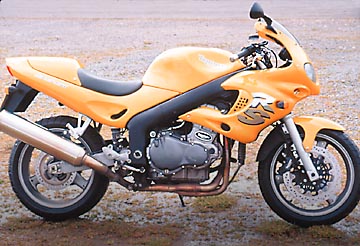 these is fashion, a subject of
which I have no understanding (ask my wife), and the other - well, like, why
change gear when you don't have to? I'd have to admit that the ability of
the RS to pull cleanly and strongly from 1,500 rpm is seductive, and makes
for some interesting acceleration tests - like crawl speed to over 160 kmh
in third gear. The real beauty of the RS/ST/Speed Triple engine is its faultless
delivery right up to the 9,500 rpm rev limiter.
these is fashion, a subject of
which I have no understanding (ask my wife), and the other - well, like, why
change gear when you don't have to? I'd have to admit that the ability of
the RS to pull cleanly and strongly from 1,500 rpm is seductive, and makes
for some interesting acceleration tests - like crawl speed to over 160 kmh
in third gear. The real beauty of the RS/ST/Speed Triple engine is its faultless
delivery right up to the 9,500 rpm rev limiter.
I've recently ridden a bunch of V-Twins in various configurations and
not found one that could match the triple at both ends of the spectrum. Either
the uneven power pulses made low rev 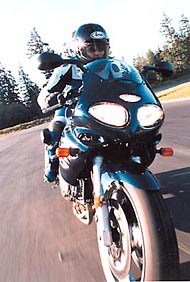 work tedious, or they buzzed mercilessly at higher revs - or both,
in the case of one high-profile European exotic. Similarly, a lauded cruiser
I rode would neither rev nor pull from low revs without sounding like a cement
mixer full of bowling balls. Three cylinders make for a pleasant sounding
and reasonably smooth motorcycle engine. Power pulses are an even 240 degrees
of revolution apart, and inherent vibration is much less than any twin configuration.
Yet the engine is compact enough to work well in a motorcycle chassis.
work tedious, or they buzzed mercilessly at higher revs - or both,
in the case of one high-profile European exotic. Similarly, a lauded cruiser
I rode would neither rev nor pull from low revs without sounding like a cement
mixer full of bowling balls. Three cylinders make for a pleasant sounding
and reasonably smooth motorcycle engine. Power pulses are an even 240 degrees
of revolution apart, and inherent vibration is much less than any twin configuration.
Yet the engine is compact enough to work well in a motorcycle chassis.
But that's all book
larnin'...
So much for theory. How
does the Sprint RS work out in practice? Remember when there was only one type
of motorcycle? What we now call a standard or retro? It had to do everything
from hauling a sidecar to road racing. Now you need a different kind of bike
for every day of the week, and two for Sundays.
If you follow motorcycle advertising, compromise is not a fashionable philosophy. But inevitably every modern motorcycle is a compromise of performance, ergonomics and price. The bike we choose just happens to suit our individual transient definition of "not compromising." In trying to define a new niche somewhere between sportbike and sport tourer, Triumph has succeeded with a brilliant trade-off. As a back-lane scratcher, the RS is fast enough and light enough, with a confidence-building plantedness that seems to defy centrifugal forces. As a sometime tourer, it's comfortable enough for 800 km days and well-mannered enough not to scare the horses. As a bar hopper, it's got great street cred, courtesy of eye-grabbing graphics. As a commuter, it's an agreeable taxi with a wild side. It'll do just about any job you want of a motorcycle - even haul a sidehack, one suspects - with a degree of...compromise. But most of all, it's just plain fun. No compromise there.
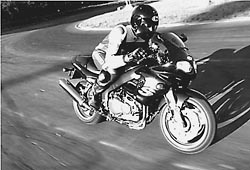 According to the words, the suspension
is taller and stiffer with shorter trail for quicker turning. Weight is trimmed
courtesy of the swingarm (now two-sided), instruments (a very compact electronic
display), bodywork etc. I expected the stiffer springs and lower weight to
cause some liveliness on rough surfaces, but no. Neither did the bicycle wander
nor get blown about on open windy roads - it always felt very stable. It's
definitely quicker to turn than the ST - it reminded me of a Buell in that
department. Riding position is compact and well tucked-in, while the narrow
bodywork cheats the wind rather than beating it. The compromises show up in
a few places. There's no gas gauge or hazard flashers, and the digital clock
rotates its display with the two trip counters - one only at a time. Forks
are adjustable for preload only. The higher-level exhaust makes for pillion
footpegs that would have your passenger's knees up around their ears (no sniggering
at the back...) and leaves little room for luggage. Then again, it's not a
tourer.
According to the words, the suspension
is taller and stiffer with shorter trail for quicker turning. Weight is trimmed
courtesy of the swingarm (now two-sided), instruments (a very compact electronic
display), bodywork etc. I expected the stiffer springs and lower weight to
cause some liveliness on rough surfaces, but no. Neither did the bicycle wander
nor get blown about on open windy roads - it always felt very stable. It's
definitely quicker to turn than the ST - it reminded me of a Buell in that
department. Riding position is compact and well tucked-in, while the narrow
bodywork cheats the wind rather than beating it. The compromises show up in
a few places. There's no gas gauge or hazard flashers, and the digital clock
rotates its display with the two trip counters - one only at a time. Forks
are adjustable for preload only. The higher-level exhaust makes for pillion
footpegs that would have your passenger's knees up around their ears (no sniggering
at the back...) and leaves little room for luggage. Then again, it's not a
tourer.
Neither does it have sportbike
redline screamability or bar-ends-on-the-deck leanability. Again, that's not
the point. But for fast cross-country work on Britain's winding A-roads while
mixing it with heavy traffic, the effortless top-gear passing and handy margin
of safety on braking and handling make it a very forgiving - and fast - package.
I enjoyed the RS best on the A47 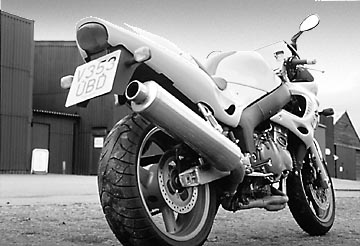 between Peterborough and Leicester.
It's a fast, twisty two-lane blacktop favoured by cross-country truckers.
That means limited overtaking opportunities and quick decisions. The Sprint's
torque allowed me to pass the trucks quickly and safely without wasting valuable
seconds changing down. The assertive brakes allowed me to recover from a mistimed
pass. And the taut handling kept me secure through adverse-camber bends as
trucks thundered by inches away. Hinckley arrived too soon, and the yellow
peril handed back to its owners.
between Peterborough and Leicester.
It's a fast, twisty two-lane blacktop favoured by cross-country truckers.
That means limited overtaking opportunities and quick decisions. The Sprint's
torque allowed me to pass the trucks quickly and safely without wasting valuable
seconds changing down. The assertive brakes allowed me to recover from a mistimed
pass. And the taut handling kept me secure through adverse-camber bends as
trucks thundered by inches away. Hinckley arrived too soon, and the yellow
peril handed back to its owners.
What we have here, if anything, is a return to the standard bike concept of yore. A basic machine that will perform most road-going duties, but with the emphasis on performance and panache. Easier to define by what it isn't, rather than by what it is. But unless your level of non-compromise is Sadam Hussein-like, the RS would probably meet your needs.
This is a fast, fun package that would satisfy any sportbike enthusiast except those for whom only a race-rep rev-rocket will do. And if you want more creature comforts, there's always the ST...
Checkout Canadian Bikers website at http://canadianbiker.com